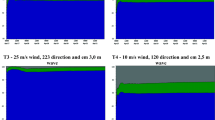Abstract
In this study, the spread of cryogenic liquid due to a limited period of release is investigated for the first time to clarify the unclear conventional concept regarding two release types, continuous and instantaneous release. In describing instantaneous release, a discharge time has been assumed to be infinitesimally small; however, such an assumption is unreal because there exists a finite period of release no matter how rapid it is. If the discharge time is less than the entire time domain, the instantaneous release model should be added to the continuous model from the end of the time. This combined release that consists of the initial continuous model and subsequent instantaneous model is more realistic than the instantaneous release. The physical phenomenon is governed by three parameters: the evaporation rate per unit area, release time, and spill quantity. Third-order perturbation solutions are obtained and compared with a numerical solution to verify the perturbation solution. For the same spill quantity, the combined model that consists of continuous and subsequent instantaneous model is necessary for small release times, whereas the continuous model is only required for large release times. Additionally, the combined release model is necessary for a small spill quantity at a fixed release time. These two release models are clearly distinguished using the perturbation solution.
Similar content being viewed by others
References
M. Kim, K. Do, B. Choi and Y. Han, First-order perturbation solutions of liquid pool spreading with vaporization, Int. J. Hydrogen Energy, 36 (2011) 3268–3271.
M. Kim, K. Do, B. Choi and Y. Han, High-order perturbation solutions to a LH2 spreading model with continuous spill, Int. J. Hydrogen Energy, 37 (2012) 17409–17414.
American Petroleum Institute, API RP 581 PART 3, Consequence analysis in an API RBI assessment, Washington, D. C., USA (2008) 8.
A. G. Venetsanos and J. G. Bartzis, CFD modeling of largescale LH2 spills in open environment, Proceedings of the First International Conference on Hydrogen Safety, Pisa, Italy (2005) 125–136.
W. Stein and D. L. Ermak, One-dimensional numerical fluid dynamics model of the spreading of liquefied gaseous fuel(LGF) on water, Lawrence Livermore National Laboratory Report No. UCRL-53078 (1980).
K. Verfondern and B. Dienhart, Experimental and theoretical investigation of liquid hydrogen pool spreading and vaporization, Int. J. Hydrogen Energy, 22(7) (1997) 649–660.
K. Verfondern and B. Dienhart, Pool spreading and vaporization of liquid hydrogen, Int. J. Hydrogen Energy, 32 (2007) 256–267.
J. Brandeis and E. Kansa, Numerical simulation of liquefied fuel spills: I. Instantaneous release into a confined area, Int. J. Numer. Methods Fluids, 3 (1983) 333–345.
J. Brandeis and D. Ermak, Numerical simulation of liquefied fuel spills: II. Instantaneous and continuous LNG spills on an unconfined water surface, Int. J. Numer. Methods Fluids, 3 (1983) 347–361.
F. Briscoe and P. Shaw, Spread and evaporation of liquid. Progr. Energy. Comb. Sci., 6 (1980) 127–140.
Author information
Authors and Affiliations
Corresponding author
Additional information
Recommended by Associate Editor Jun Sang Park
Myungbae Kim received his Ph.D. at Department of Mechanical Engineering, Korea Advanced Institute of Science and Technology in 1996. His research interests include spread of liquid pool and fire and explosion consequence analysis in the plant safety study.
Rights and permissions
About this article
Cite this article
Kim, M., Kim, T. & Choi, B. Study of continuous spill with a limited period of release. J MECH SCI TECHNOL 28, 4331–4337 (2014). https://doi.org/10.1007/s12206-014-0947-z
Received:
Revised:
Accepted:
Published:
Issue Date:
DOI: https://doi.org/10.1007/s12206-014-0947-z




